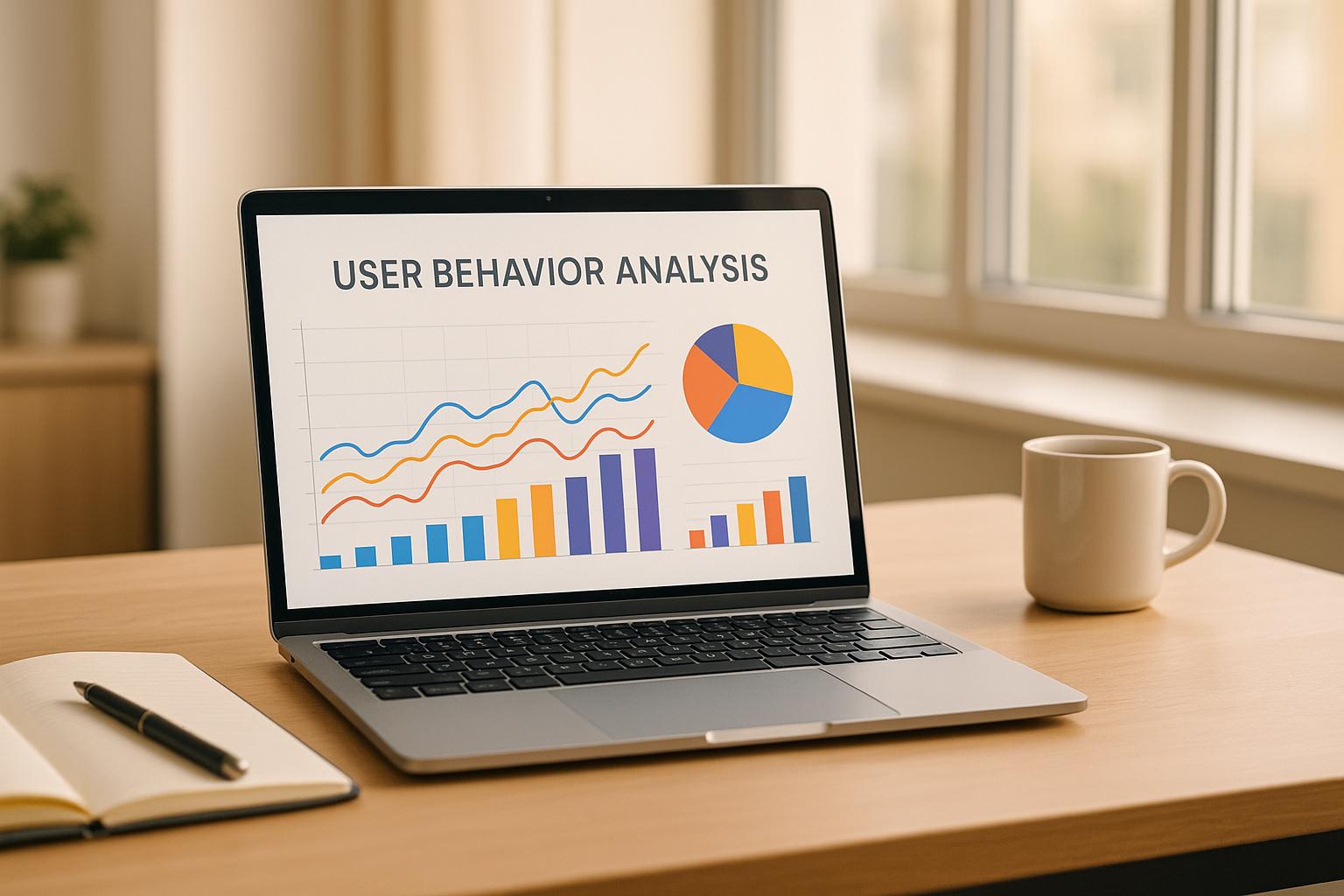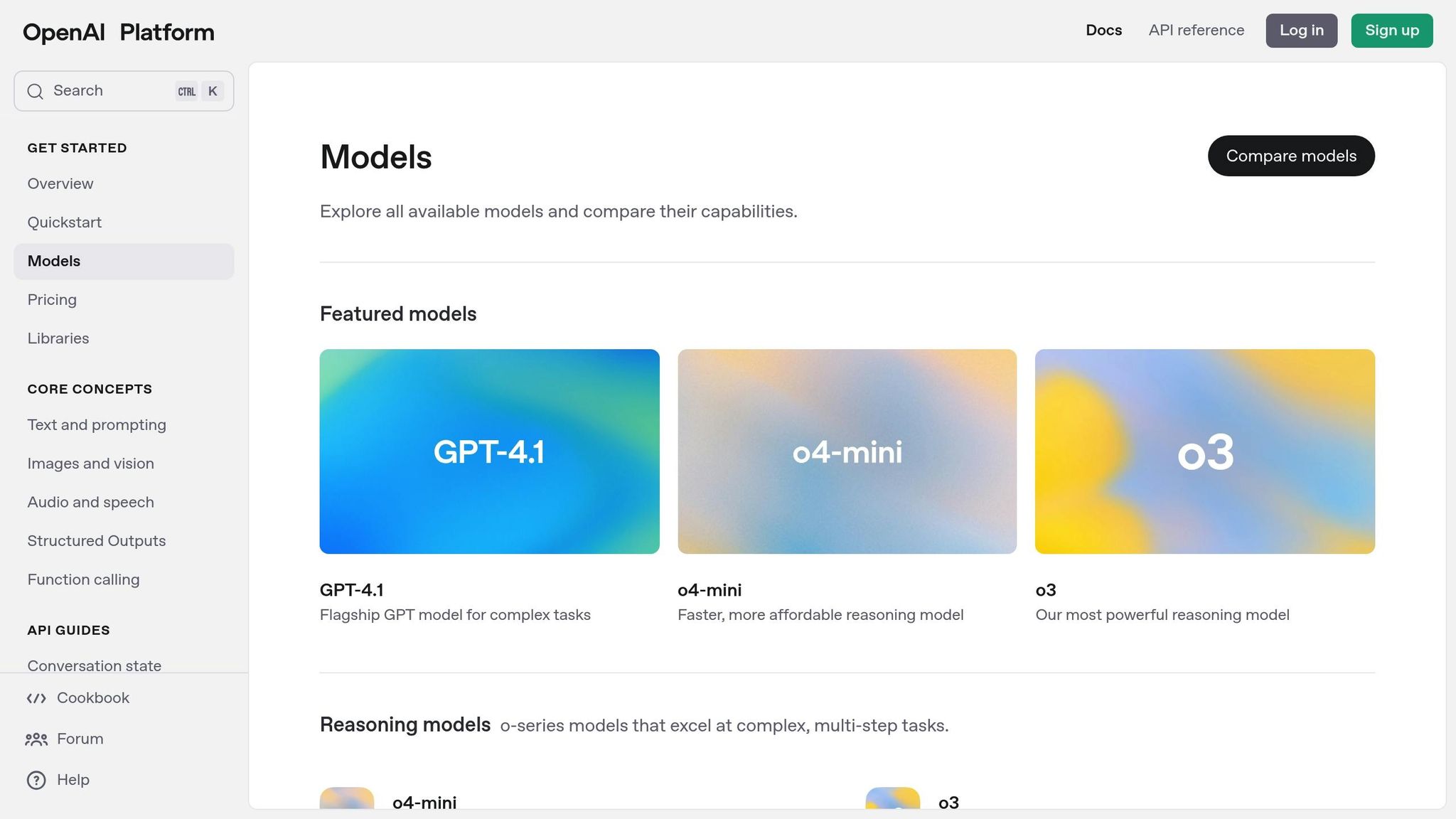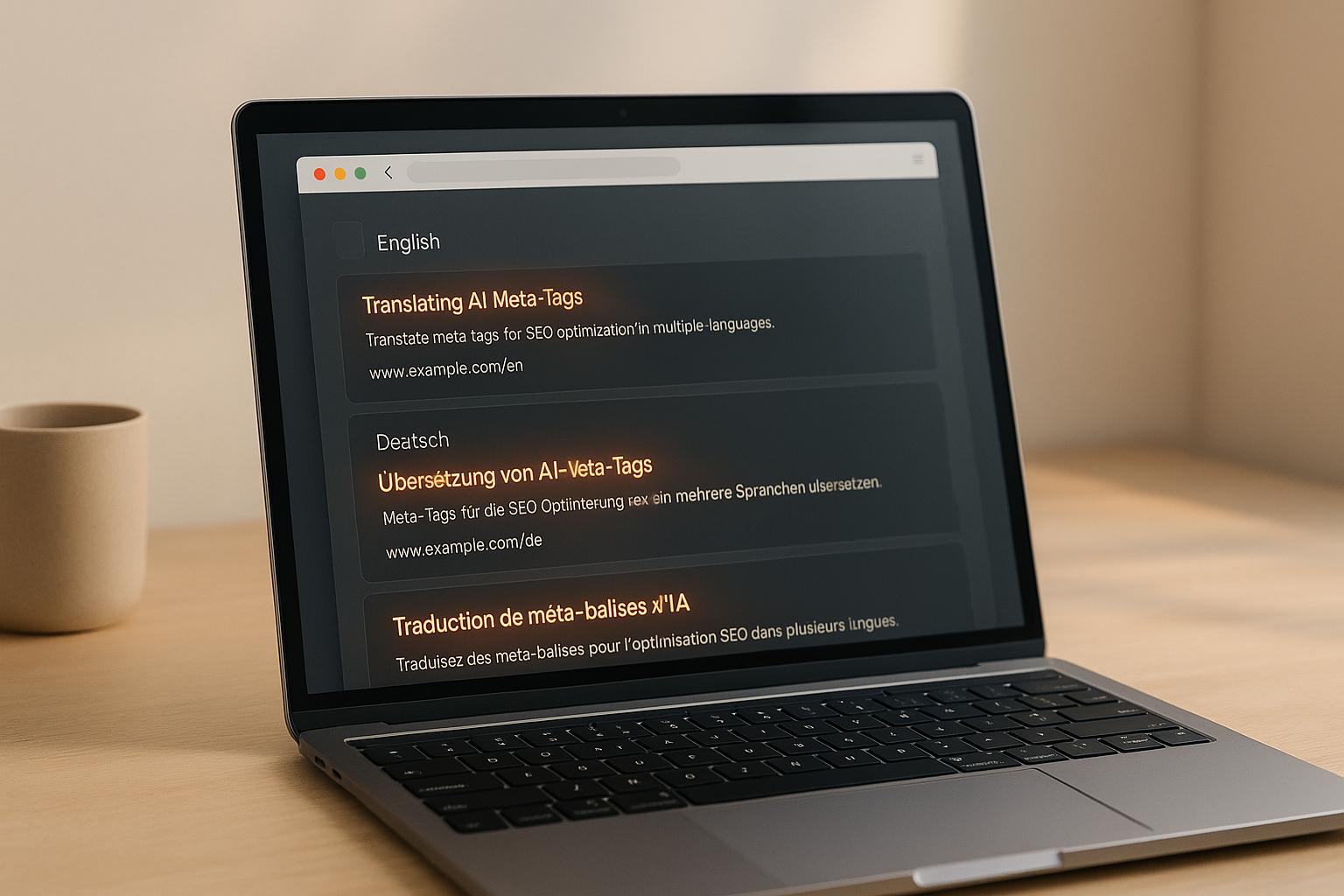

How to Identify User Intent with AI Tools

How to Identify User Intent with AI Tools
 27-06-2025 (Last modified: 23-09-2025)
27-06-2025 (Last modified: 23-09-2025)
AI tools can help you understand what users want by analyzing their behavior, search patterns, and interactions. This allows businesses to create targeted content, improve user experiences, and boost conversions.
Here’s a quick breakdown of how AI identifies user intent:
- Behavior Tracking: AI analyzes clicks, time spent on pages, and navigation paths to spot patterns in user actions.
- Types of Intent:
- Informational: Users seek answers or knowledge (e.g., “how to lose weight naturally”).
- Navigational: Users aim to reach specific sites (e.g., “LinkedIn login”).
- Transactional: Users are ready to act, like making a purchase (e.g., “buy iPhone 14 Pro Max”).
- Content Optimization: AI tools like PageTest.AI test and refine content (headlines, CTAs) to match user intent.
- Predictive Analytics: AI forecasts future actions, helping businesses anticipate needs and adjust strategies.
By using AI for intent analysis, companies can improve lead conversion rates, engagement, and overall ROI. For instance, businesses leveraging intent data saw up to a 30% boost in lead conversions.
Want to improve your strategy? Start by defining goals, collecting quality data, and using AI tools to test and refine content.
Build a Customer Intent Classification Application with OpenAI GPT3 | No-Code

Types of User Intent
Grasping the different types of user intent is crucial for connecting with your audience. Each type reflects a specific stage in the user journey, allowing you to tailor your message to meet their needs at the right time.
With 3.8 million Google searches happening every minute, the sheer volume of intent signals is staggering. AI tools shine here, analyzing this massive data flow to uncover patterns that would be nearly impossible to spot manually.
Let’s break down the main categories of user intent and how they influence website strategy.
Informational Intent
Users with informational intent are in learning mode. They’re searching for answers, insights, or solutions to specific questions. These users are focused on research, not immediate purchases.
Typical search patterns include phrases like "how to lose weight naturally" or "history of the French Revolution". These queries often start with words like "how", "what", or "why", making it clear that these users are looking to understand or solve a problem.
To engage this audience, your content should focus on providing value and expertise. Think blog posts, how-to guides, instructional videos, or even infographics. The aim is to deliver clear, actionable insights that establish your brand as a go-to resource.
Navigational Intent
Navigational intent comes into play when users already know where they want to go. Instead of typing the full URL, they use search engines to quickly reach a specific website or service.
Common search terms include "LinkedIn login" or "Facebook homepage". These users have a clear goal: to reach a particular destination as efficiently as possible.
For this type of intent, your website should focus on ease of access. Intuitive navigation menus, clear call-to-action buttons, and a strong internal search function are essential. If users are actively looking for your brand, make sure they can find everything they need without frustration.
AI tools can also enhance navigational experiences by identifying frequently searched brand terms, ensuring a smoother path for users.
Transactional and Commercial Intent
Transactional and commercial intent users are ready to act – though their readiness levels may vary. These users know what they want and are seeking the best way to achieve their goal, whether it’s buying a product, subscribing to a service, or downloading a resource.
Search queries often include terms like "buy", "order", or specific product names. Examples might be "buy iPhone 14 Pro Max" or "best deal on Fitbit Charge 5". These users are at the decision-making stage, representing some of the most valuable traffic.
Commercial intent users, on the other hand, are still weighing their options. They might search for "best noise-canceling headphones under $200" or "iPhone vs. Samsung Galaxy features comparison". These users are comparing features, reading reviews, and hunting for the best deal.
To cater to these users, your site should focus on eliminating obstacles to conversion. Key strategies include clear call-to-action buttons, detailed product descriptions, customer reviews, fast load times, mobile-friendly design, and a seamless checkout process.
AI tools are particularly effective here, identifying the precise moment when users shift from browsing to buying. For example, RTB House’s tests with IntentGPT revealed a 44% average increase in engagement rates when campaigns aligned with user intent.
"IntentGPT reads and understands a page in its entirety, deriving deep meaning from the content, the same way a human would. We can implement this technology at scale and do it in 49 languages across the internet in near real time." – Jaysen Gillespie, RTB House
Platforms like PageTest.AI take this further by generating AI-driven content variations tailored to different intent types. By testing headlines, product descriptions, and call-to-action buttons, you can pinpoint what resonates most with each user segment. With the ability to test multiple variations simultaneously, the platform helps you refine your messaging for both transactional and informational audiences more effectively.
How AI Tools Identify User Intent
AI tools have changed the way businesses understand what users are actually looking for. By analyzing massive amounts of data, these tools uncover the motivations behind user actions. This process relies on three main approaches that work together to paint a clear picture of user intent.
Behavioral Analytics and User Tracking
AI is exceptionally good at spotting patterns in how people interact with websites and apps. It tracks details like clicks, scroll depth, time spent on pages, and navigation paths. By analyzing both historical and real-time data, AI identifies trends that might otherwise go unnoticed.
These systems gather data from various touchpoints, such as user interactions, transaction histories, and device usage. For instance, if a user spends several minutes reading product reviews instead of quickly scrolling past them, AI can recognize this as a shift from casual browsing to serious consideration or purchase intent. Using machine learning models, including supervised learning and recurrent neural networks, the technology maps observed behaviors to potential future actions.
A practical example is AI-powered speech analytics, like the tools offered by Convin.ai, which detect emotional cues in customer calls. These tools can identify frustration or satisfaction and alert agents to intervene or escalate the issue when needed.
Businesses that monitor user behavior see double the profit and a 115% greater ROI. AI takes this further by segmenting users into groups based on shared behaviors, purchase histories, and interactions. This segmentation helps businesses understand not just what users do, but why they act that way.
These behavioral insights lay the groundwork for advanced testing methods.
Automated A/B and Multivariate Testing
AI-powered A/B and multivariate testing help businesses quickly figure out what content works best for different user groups, leading to better engagement and higher conversion rates.
Unlike traditional testing, AI can handle multiple ideas across entire user journeys instead of focusing on just one page. It creates personalized experiences by generating and testing numerous content variations automatically. For example, PageTest.AI uses AI to tailor content – like headlines, product descriptions, and call-to-action buttons – to match different types of user intent, whether informational or transactional. With its no-code Chrome extension, businesses can easily select website elements and let AI generate and test multiple variations.
AI also makes real-time adjustments based on user behavior. This iterative process uncovers deeper insights into user intent. Multivariate testing takes things further by analyzing how multiple elements – like headlines, images, and call-to-action buttons – work together. Instead of testing one element at a time, AI evaluates combinations to find the mix that drives the most engagement for each user group.
Once these insights are gathered, predictive analytics comes into play to forecast future user actions.
Predictive Analytics for Intent Prediction
The most advanced AI tools go beyond analyzing current behavior – they predict what users will do next. By studying historical search data and behavioral trends, machine learning models anticipate user needs. This predictive capability shifts how businesses approach user intent entirely.
AI also uses Natural Language Processing (NLP) to understand the context behind search queries and social media interactions. By identifying relationships between words and concepts, it can decode even complex or indirect queries.
This technology has practical benefits. For example, companies using intent recognition tools report a 50% reduction in average response times for customer inquiries. Additionally, businesses adopting AI-driven solutions save about 40% on operational costs.
Predictive analytics doesn’t just focus on individual interactions – it tracks customer touchpoints across multiple channels to foresee potential issues. For instance, during peak demand periods, AI can analyze past interactions to predict common customer questions. If a user has previously faced billing problems, the system might prompt agents to proactively address those concerns when the user reaches out again.
AI also identifies high-intent keywords to optimize landing pages and improve conversions. By analyzing engagement patterns, it predicts seasonal trends, allowing businesses to adjust their content strategies ahead of time. It can even differentiate between behaviors on different devices to deliver results that are more relevant to the user’s context.
Together, behavioral tracking, testing, and predictive analytics form a comprehensive system for understanding and acting on user intent.
DemandScience’s 2022 report revealed that 17% of B2B sales and marketing professionals improved their lead conversion rates by 30% using intent data. This highlights the tangible benefits of predictive analytics in helping businesses meet user needs effectively.
sbb-itb-6e49fcd
Steps to Implement AI-Based User Intent Analysis
Getting started with AI-based user intent analysis might seem like a big task, but breaking it down into manageable steps can make the process much smoother. By focusing on clear goals, reliable data, and continuous optimization, you can integrate AI effectively into your marketing and conversion strategies.
Define Conversion Goals and Metrics
Before diving into AI tools, it’s crucial to define what success looks like for your business. As Seth Godin wisely says, "A useful metric is both accurate (in that it measures what it says it measures) and aligned with your goals. Don’t measure anything unless the data helps you make a better decision or change your actions".
For B2C companies, this might mean tracking purchase completions, email sign-ups, or time spent on product pages. For B2B businesses, the focus could shift to lead generation, demo requests, or whitepaper downloads. Once these goals are clear, set up event tracking to monitor specific user actions like button clicks, form submissions, and downloads. This granular data helps AI tools identify the smaller steps (micro-conversions) that lead to your primary objectives.
The payoff can be impressive. For instance, HubSpot reported a 94% higher conversion rate on AI-generated email campaigns compared to non-AI campaigns.
Collect and Segment User Data
With your goals in place, the next step is gathering high-quality user data. Focus on collecting information from various touchpoints, such as website interactions, purchase history, email engagement, social media activity, and customer service interactions. Pay attention to both behavioral patterns and demographic details.
Quality matters more than quantity here. Validate, clean, and standardize your data to ensure it’s reliable. Businesses that use AI for audience segmentation have reported conversion rate improvements of up to 25%, customer retention gains of up to 30%, and an average ROI increase of 23% compared to 15% with traditional methods. It’s no surprise that 55% of marketers already use AI for segmentation and targeting.
Segment your audience into meaningful groups based on shared behaviors or characteristics that align with your marketing goals. Take a cue from Amazon, which uses AI-powered segmentation to tailor campaigns and has seen a 25% boost in sales. Don’t forget to prioritize ethical practices by obtaining explicit consent, being transparent about data usage, and ensuring secure storage and anonymization to comply with regulations like GDPR and CCPA.
Use AI Tools to Test and Optimize Content
Once you have clean data and clear goals, start testing and refining your content with AI tools. Platforms like PageTest.AI offer an easy way to align your content with user intent. For example, its Chrome extension allows you to select specific website elements – like headlines, call-to-action buttons, or product descriptions – and generate multiple variations tailored to different user intents.
The platform tracks metrics like clicks, engagement rates, time on page, and scroll depth, giving you a clear picture of how each content variation performs. Plus, it integrates smoothly with popular website builders, making it accessible even for non-technical users.
Match your content to the type of user intent for better results. For informational searches, focus on guides and tutorials. For commercial intent, use comparisons and demos. For transactional intent, emphasize pricing pages, onboarding guides, and success stories. The power of AI lies in its ability to continuously test and optimize in real time, helping you uncover what truly resonates with each audience segment.
Refine and Personalize Based on Insights
The final step is to use the insights you’ve gathered to fine-tune your strategy. For example, if a user spends time on detailed product specifications, follow up with more technical content. If they skim overview pages, offer simplified comparisons and clear next steps.
Regularly review your data to spot trends and new opportunities. Keep in mind that user intent isn’t static – it shifts with market trends, seasons, and product updates. Automated reports can help you monitor these changes. A/B testing remains a valuable tool for validating your ideas, and companies using AI-powered segmentation have reported a 15% boost in revenue and a 12% decrease in customer churn.
Machine learning can further refine your personalized campaigns as it processes more behavioral data. Real-time updates to your audience data ensure you’re always tracking how segments interact with your content, allowing for continuous adjustments. This creates a feedback loop that strengthens your AI-driven strategy, ensuring ongoing improvements in your conversion efforts.
Measuring the Impact of AI-Driven User Intent Analysis
After implementing AI-driven user intent analysis, the next step is figuring out how well it’s working. Without tracking results, it’s impossible to understand whether the AI is delivering value.
Key Performance Indicators (KPIs) are essential for evaluating success. They provide a clear way to measure how the AI is performing, ensure your efforts align with business objectives, guide data-based improvements, and showcase the overall impact of your AI project.
Key Metrics to Track
When it comes to AI-driven user intent analysis, there are several important metrics to monitor:
- Conversion-related metrics: Keep an eye on overall conversion rates, lead conversion rates, and revenue per visitor. These metrics directly show whether your AI tools are driving tangible results for your business.
- Engagement metrics: Metrics like time on page, bounce rate, pages per session, and scroll depth help you understand how well your content connects with users. For instance, a 2023 Ascend2 study revealed that 48% of active intent data users reported highly successful go-to-market strategies, compared to just 17% of those who didn’t use such data.
- Traffic quality metrics: Analyze organic traffic growth, click-through rates, and the percentage of qualified leads to confirm that your traffic includes high-value prospects.
- Content performance indicators: Identify which pages and content formats generate the most conversions, and evaluate the success of different content variations.
To make tracking easier, set up custom dashboards in your analytics tools. These dashboards provide a centralized view of your intent-related KPIs, helping you stay on top of performance.
Once you’ve established these KPIs, compare the results from before and after implementing AI to measure your progress.
Before-and-After Comparisons
One of the best ways to show the impact of AI is by comparing key metrics from before and after its implementation. Start by establishing baseline measurements, then track the same metrics post-implementation to highlight any improvements.
For example, a McKinsey study found that 35% of companies are using AI in marketing and sales, with conversion rate optimization being a top use case for improving customer journeys and boosting ROI. Documenting changes in monthly averages, quarterly trends, and year-over-year growth can provide a clearer picture of AI’s impact.
When evaluating manual A/B testing against AI-powered testing, keep both efficiency and effectiveness in mind. Manual testing often takes weeks to set up and analyze, while AI platforms can test multiple variations simultaneously, delivering faster and more actionable results.
| Metric | Before AI Implementation | After AI Implementation | Improvement |
|---|---|---|---|
| Conversion Rate | 2.3% | 3.1% | +34.8% |
| Time on Page | 1:45 | 2:32 | +44.8% |
| Bounce Rate | 68% | 52% | -23.5% |
| Lead Quality Score | 6.2/10 | 8.1/10 | +30.6% |
Using tools like heat maps alongside A/B testing can give you even deeper insights into how users interact with different content versions. This data doesn’t just show what’s working – it helps explain why it’s working.
Frequent reviews are essential for spotting trends and understanding long-term benefits. While monthly reviews can help with short-term adjustments, quarterly and annual assessments are better for seeing the bigger picture as your AI system continues to learn and improve.
Real-World Examples
These metrics aren’t just theoretical – they’re already being put into practice by top companies. For example, Sephora’s Beauty Insider loyalty program uses AI for predictive analytics and customer segmentation. This allows them to identify trends and preferences among returning customers, offering personalized rewards and recommendations based on purchase intent. Similarly, eBay uses machine learning to refine its marketing campaigns by analyzing user behavior and identifying high-intent buyers. Their multi-relevance ranking model considers a variety of purchase intent signals beyond simple clicks.
Conclusion and Key Takeaways
AI-powered user intent analysis has reshaped how businesses respond to customer needs. By April 2025, 40% of search engine result pages now include AI-generated overviews – a notable jump of 25% since August 2024. This shift opens up new opportunities for implementing strategies that directly impact conversions.
The key to success lies in blending an understanding of user behavior with actionable optimization techniques. When paired with AI testing tools, this approach allows for more precise targeting, ultimately improving conversion rates.
While creating content still requires a human touch – focusing on quality and tone – technical optimizations also play a major role. Features like optimized snippets and long-tail keywords can significantly boost performance. For instance, enhancing featured snippets can increase click-through rates by 42%, while incorporating long-tail keywords improves snippet visibility by 55.5%.
Practical application is just as important as technical details. Tools like PageTest.AI eliminate the need for lengthy manual A/B testing setups, enabling businesses to test and track performance metrics quickly and efficiently.
To sustain success, consistent measurement and refinement are non-negotiable. Regular content audits and close monitoring of engagement metrics ensure strategies remain effective. Additionally, AI tools not only help track website rankings but also improve the contextual relevance of your content, driving better overall performance.
FAQs
How can businesses ensure their data is accurate and reliable for AI-based user intent analysis?
To get reliable results from AI-driven user intent analysis, businesses need to focus on gathering high-quality data. This means ensuring the data is accurate, complete, and relevant. It’s also crucial to regularly clean the data to eliminate inconsistencies, duplicates, and missing information.
Including diverse and impartial data sources can make AI models perform better while reducing bias. By routinely reviewing and updating datasets, businesses can keep them aligned with changing user behaviors, leading to insights that are more dependable and reflective of real-world trends.
How can AI tools help increase user engagement and boost conversion rates?
AI tools are reshaping the way businesses interact with users and boost conversions by offering personalized, data-based experiences. Take AI-powered recommendation engines, for example – they suggest products tailored to individual preferences, which not only grabs attention but also encourages purchases. Similarly, dynamic pricing models and targeted marketing campaigns rely on AI to study user behavior and present customized deals, leading to better conversion rates. This approach helps businesses build stronger connections with users, enhancing both customer satisfaction and profitability.
How can AI identify different types of user intent, and how should businesses adapt their strategies?
AI figures out what users want by analyzing the context, keywords, and patterns in their queries. It uses advanced machine learning to sort these intents into three main categories: informational intent (users looking for knowledge or answers), navigational intent (users searching for a specific site or page), and transactional intent (users ready to take an action, like buying something or signing up).
For businesses, understanding these intents is a game-changer. If a user has informational intent, offering clear, detailed answers can help establish trust. For navigational searches, make sure your website is easy to locate and simple to navigate. And when it comes to transactional intent, focus on making the process as smooth as possible – think optimized calls-to-action, easy-to-use forms, and a hassle-free checkout. Aligning your strategy with what users want can lead to better engagement and stronger results.
Related Blog Posts
say hello to easy Content Testing
try PageTest.AI tool for free
Start making the most of your websites traffic and optimize your content and CTAs.
Related Posts

 15-11-2025
15-11-2025
 Ian Naylor
Ian Naylor
Best Practices for AI Meta Tag Translation
Learn how AI-driven meta tag translation enhances multilingual SEO by improving engagement and search rankings through efficient localization.

 13-11-2025
13-11-2025
 Ian Naylor
Ian Naylor
AI Tools for Testing Visual Hierarchy
Explore how AI tools can enhance your website’s visual hierarchy, improving user experience and boosting conversion rates significantly.

 11-11-2025
11-11-2025
 Ian Naylor
Ian Naylor
How to Analyze Mobile Abandonment Patterns
Understand mobile abandonment patterns to enhance user experience and recover lost revenue by addressing key friction points during checkout and onboarding.
